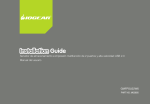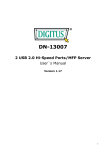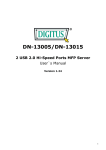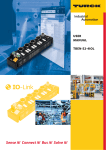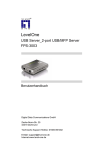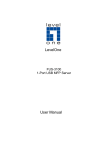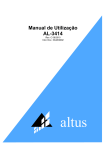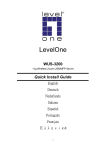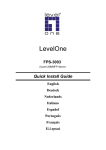Download iogear GMFPSU22W6 print server
Transcript
Installation Guide USB 2.0 Hi-Speed 2-Port Multifunction Print and Storage Server User Manual GMFPSU22W6 PART NO. M0389 Introduction Thank you for purchasing the IOGEAR GMFPSU22W6 2 Port USB 2.0 Multifunction Print and Storage Server (hereafter referred to as “server”). This server is designed to connect your All-In-One/Multifunction devices, standard printers, and USB storage devices (hard drives, flash drives, and memory card readers) to your network, allowing all network users access to these shared USB resources. About this Manual This manual provides introductory information as well as detailed instructions on how to set up and manage the IOGEAR GMFPSU22W6 in various network environments. To fully benefit from this document, you should be familiar with basic networking principles. The instructions described in this manual are based on the settings in a new server. If needed, you can reset the server back to the factory defaults. For details, please refer to the chapter “Restore Factory Defaults”. Table of Contents Package Contents 6 Customer Support 29 Physical Description 7 Radio & TV Interference Statement 30 Hardware Installation 9 Limited Warranty 31 Software Installation 10 Configuring the Server IP 18 Printer/Fax/Scanner Setup (Virtual USB) 21 Storage Setup (Windows File Sharing/SMB) 23 Storage Setup (Virtual USB) 24 Restore Factory Defaults 28 Package Contents Verify that nothing is missing from the package by using the checklist below. Please contact your dealer if anything is missing or damaged. All packing materials are recyclable. Please confirm the items in the package below: 1 x USB Multifunction Print and Storage Server 1 x Quick Start Guide 1 x Software CD 1 x Power adapter 1 x Warranty/Registration card Physical Description 1. Power Adaptor Connector: DC IN 12V/1A adapter 2. Init Button: restores all settings to default values 3. Ethernet Connector: a twisted pair category 5 cable 4. USB Host Ports: USB 1.1/2.0 low, full, and hi-speed compliant 5. Indicator Lights Indicator Behavior Description Power Lit Power On Not lit Power off/System error Lit Network connected Not Lit No physical connection to network Blinking Activity on network Not lit No activity on network Lit USB device connected Blinking Connected USB device error Not lit No physical connection to USB device Lit USB device connected Blinking Connected USB device error Not lit No physical connection to USB device Link Status USB1 USB2 Hardware Installation Make sure that your USB devices are switched off and that the server’s power adapter is disconnected. Connect the print and/or storage devices to the server’s USB ports. Connect the server to the network with the included Ethernet cable. Turn on the USB devices and make sure they are ready for use. Connect the power adapter to the server. The power indicator will light up and USB1 and USB2 indicators will flash in turn. When the Link indicator lights up, the Server is correctly connected to the network. When USB1 and USB2 indicators do not flash, the Server is working normally. Software Installation Insert the Software CD into your computer. A splash screen should appear with a menu of options. Click on the words Install Application to set up the server’s Control Center software. 10 Click Next to continue the installation wizard. 11 Type your name and organization to personalize the installation of the Control Center software, then click Next to continue. 12 Click Change… if you would like to install the software to somewhere besides the default location, then click Next to continue. 13 Click Install and wait a moment for the Control Center software to finish loading. 14 Click Finish to exit the install wizard and launch the Control Center software for the first time. 15 If you have a software firewall you may be alerted that the Control Center is being blocked. Make sure that you unblock the Control Center or you may experience difficulty using your server. If you need to manually configure your firewall, make sure the following ports are open for both TCP and UDP: 7303, 7305, 20005, 30201, 30202, and 30203. 16 After a moment your print server should appear in the server list. Click the server name once and any attached devices should be listed below it. This means your Control Center software is installed properly. You may close the window using the X in the top right corner and the Control Center will continue to run in the background. If you wish to open the Control Center again simply double-click the grey IOGEAR icon in the system tray area by your clock. 17 Configuring the Server IP You may wish to manually assign an IP address to the server in some cases. For example, if you do not have a DHCP server on the network. Most users who have a router that acts as a DHCP server can skip this section, however. To configure the server IP, double click on the server in the Control Center’s server list. 18 At the prompt, enter the administrator username (default: admin) and password (default: admin). 19 After you have logged in successfully, select the TCP/IP tab. Here you may select Static IP and manually configure all network settings for the server. 20 Printer/Fax/Scanner Setup (Virtual USB) Your print server supports a technology called Virtual USB in addition to more traditional print server ports. A Virtual USB connection allows your printer software to think the printer is connected directly to your computer, for maximum compatibility. All fax and scan features of a multifunction printer will work as expected. Using this method is very similar to setting up the printer without a print server. Simply follow your printer’s setup instructions but instead of connecting the printer to the computer when asked, select the printer in the Control Center software and press the Connect button on the toolbar. 21 Your printer should be detected and installed automatically at this point. You can repeat this setup procedure on all your computers as needed. One weakness of the Virtual USB technology is that only one computer can be connected to the printer at a time. For this reason it is recommended that you set your printer to auto-connect if you will be using it regularly. In the Control Center software select the printer again and click on the Auto-Connect Printer button on the toolbar, then on Set AutoConnect Printer. You will see a list of all printer icons available on your computer. Check the box in front of the appropriate model and click the Apply button. Now whenever you print a document the Control Center software will attempt to automatically restore the link to your printer. 22 Storage Setup (Windows File Sharing/SMB) with multiple disks or a USB hub) and the third x represents the number of the partition. You may read or write to any FAT or FAT32 disk in this way, and read but not write to NTFS disks this way. If you need read/write access to an NTFS disk you must use Virtual USB mode (see below). Storage devices attached to your server are accessible through Windows File Sharing and FTP protocols. For local network access, Windows File Sharing is the preferred method. To browse the shared files, start by opening Internet Explorer or any Windows Explorer window with an Address bar. Type “\\GMFPSU22W6” into the address bar (without the quotes) and hit enter to see what is being shared by the server. All storage will be labeled according to the convention USBx_DxPx, where the first x represents the number of the USB port of the server, the second x represents the number of the Disk (usually 1 unless you attach a device 23 Storage Setup (Virtual USB) To gain full control of NTFS disks you will need to use the Virtual USB mode for storage devices. In this mode only one computer has access to a disk at a time, but any disk operation is possible including formatting or partitioning. Once you turn on Virtual USB mode for storage devices, all storage devices can only be accessed in this way. Plan carefully which mode is the best match for your needs. 24 To turn on Virtual USB mode, open the Control Center software and double click on the server name in the list. Enter the administrator username (default: admin) and password (default: admin) at the prompt. Switch to the Supported Protocols tab. In the lower right, select Virtual USB mode for storage access. Click Apply and allow the server to restart so that the change takes effect. 25 Once this is done, you may connect or disconnect from storage devices in the same way you would a printer. Simply open the Control Center interface, select a storage device and click the Connect button in the toolbar. The storage device will be detected as if plugged directly into a USB port on your computer. No other computers will be able to access the device while it is connected in this way. 26 When you are done using the drive, click the Safely Remove Hardware icon in the tray area by your clock to prevent further communication with the drive and help protect against data loss. Once this step is completed you may use the Control Center software to disconnect the drive and allow others to connect to it. 27 Restore Factory Defaults If you are having difficulty finding or connecting to your print server using the Control Center software due to network issues or a forgotten password, you can clear all settings on the server using the Init button on the device. To properly reset all settings to factory defaults, unplug the power adapter from the device. Then hold the Init button and plug the power adapter back in. Instead of blinking alternately as during a normal startup, the USB1 and USB2 lights should begin blinking at the same time. Unplug the power adapter once again, and then plug in the adapter without holding the Init button. The server should go through the normal startup process and all network and password settings will be at defaults. 28 Customer Support Should you require any technical assistance, call toll-free: 866-9-IOGEAR (866-946-4327) or visit our website at http://www.iogear.com for the latest product information and support files. This document is subject to change without prior notice. 29 Radio & TV Interference Statement WARNING!!! This equipment generates, uses and can radiate radio frequency energy and, if not installed and used in accordance with the instruction manual, may cause interference to radio communications. This equipment has been tested and found to comply with the limits for a Class B computing device pursuant to Subpart J of Part 15 of FCC Rules, which are designed to provide reasonable protection against such interference when operated in a commercial environment. Operation of this equipment in a residential area is likely to cause interference, in which case the user at his own expense will be required to take whatever measures may be required to correct the interference. 30 Limited Warranty IN NO EVENT SHALL THE DIRECT VENDOR’S LIABILITY FOR DIRECT, INDIRECT, SPECIAL, INCIDENTAL OR CONSEQUENTIAL DAMAGES RESULTING FROM THE USE OF THE PRODUCT, DISK, OR ITS DOCUMENTATION EXCEED THE PRICE PAID FOR THE PRODUCT. The direct vendor makes no warranty or representation, expressed, implied, or statutory with respect to the contents or use of this documentation, and especially disclaims its quality, performance, merchantability, or fitness for any particular purpose. The direct vendor also reserves the right to revise or update the device or documentation without obligation to notify any individual or entity of such revisions, or updates. For further inquires please contact your direct vendor. 31 About Us FUN IOGEAR offers connectivity solutions that are innovative, fun, and stylish, helping people enjoy daily life using our high technology products. GREEN IOGEAR is an environmentally conscious company that emphasizes the importance of conserving natural resources. The use of our technology solutions helps reduce electronic waste. HEALTH IOGEAR supports healthy and fit lifestyles. By integrating products with the latest scientific developments, IOGEAR’s solutions enhance the life of end-users. © 2007 IOGEAR, INC.
































